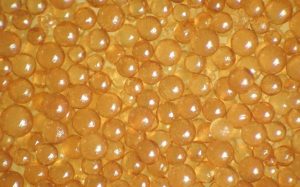Ion Exchange Resin Manufacturing
To understand the parameters involved we need to know the ingredients and how they can affect physical and chemical stability of the finished resin. The main ingredients used to make strong acid cation (SAC) resins are styrene (S)(also known as ethenylbenzene, vinylbenzene, and phenylethene), divinylbenzene (DVB) and sulfuric acid (H2SO4).
Since this is a two-step process, we also need to identify what is critical in each step. Combining styrene and polymerizing it yields polystyrene (PS)- a ubiquitous polymer where extruded sheets can be thermo-formed or polystyrene beads injection molded to make drinking cups; extruded or expanded to make insulation materials, etc. Though polystyrene has many uses, it is not strong enough on it’s own. To strengthen the structure bond of polystyrene it is co-polymerized with divinylbenzene. DVB is also called a cross-linking agent as it connects the long PS chains and bonds to the PS chains above and below.
 How to make water softener resin beads
How to make water softener resin beads
Other important facts on DVB and “resins” is the greater the DVB to styrene in the S- DVB copolymer, the higher the operating capacity & bead strength of the resultant ion exchange bead. The general relationship of bead toughness is directly proportional to DVB content. While it’s not a straight line relationship, where an “8% cross linked (CL) cation” does not have four times the toughness of a “2% CL cation”, the general rule of thumb is that capacity and hardness increase with DVB holds. Since we know DVB cross-links the long chain PS molecules and that is also the point at which the functional groups are attached means varying the amount of DVB in the S-DVB recipe will change the properties of the final resin. For example, it’s possible to make SAC resin with varying levels of DVB (2% to 20%) and as the DVB level rises so does the theoretical exchange capacity (TEC).
Once a hard co-polymer bead is made it is then introduced into another reactor and filled with a high concentration of sulfuric acid. Some energy is imparted to the mixture which starts the exothermic reaction that ultimately transforms the inert plastic beads into a swollen (with water) ion exchange resin. The key part to this process is the dissociation of sulfuric acid to form a reactive nuclear sulfonic acid that bonds to the backbone where DVB cross-links the S-DVB matrix.
Credit:
Jim Sabzali
